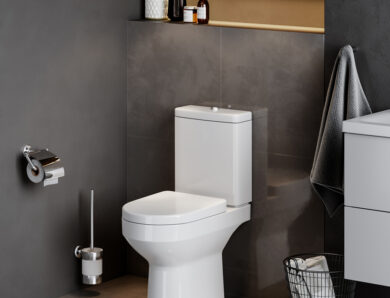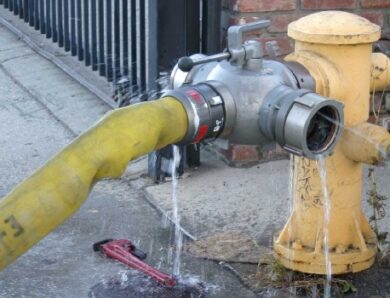Insulation of air ducts. Types of thermal insulation, methods of installation and fastening
Ventilation and air conditioning systems are indispensable tools to ensure a comfortable human life in the premises, having a complex layout and a fairly large area. The main problem, with which it is necessary to face at operation of air ducts - the increased formation of condensate. For, that the clean air supply system worked long and correctly, the air duct must be properly insulated.
Insulation of air ducts is a necessary measure, which increases the efficiency of the system and reduces heat loss
What is the thermal insulation of air ducts?
Due to the timely insulation of air ducts, you can solve several important tasks:
- reducing the amount of heat loss;
- fire prevention inside the duct and additional fire protection;
- noise reduction, arising from the passage of air flows through the duct;
- protection of internal and external surfaces of air channels from condensate.
pay attention! The most serious function of thermal protection of air ducts can be called the prevention of condensation. Elements of the ventilation system, not protected by thermal insulation, almost always covered with condensate, especially in the cold period, when the air ducts are quite warm and humid air.
Condensation not only spoils the appearance of the room and causes mold ??and fungus on air ducts and adjacent surfaces: water drops, falling on the ventilation ducts, have a very aggressive chemical composition, therefore, they can damage all metal elements of the air supply system in a very short time. With the help of thermal insulation, the surface temperature of the air duct is constantly above the dew point, therefore condensation of moisture does not occur.
Thermal insulation is also required for systems, used to transport cold air. In this case, the opposite problem arises - cold air flows are heated by the surrounding air with warm air, which reduces the efficiency of the air conditioning system and requires an increase in resources used or additional design settings.
The insulated air duct is not covered with condensate and produces less noise during operation
Noise reduction, produced by the air duct during operation, also able to extend the life of the system. Noise insulation helps reduce vibration, which prevents wear of metal parts of the ventilation duct.
What materials are used to insulate ventilation systems?
All materials, used for thermal insulation of air ducts, first of all must meet all modern requirements of fire safety and sanitary norms. Materials recommended for air duct insulation are divided into several categories:
Closed-cell foamed polyethylene. The main area of its application is the isolation of forced ventilation systems with a cross section of small or medium area. It usually consists of several layers (two or three): polyethylene foam and aluminum foil, which has properties, reflective. Foamed polyethylene may have an adhesive layer on the inside, then this insulation will be self-adhesive. The presence of waterproof glue greatly simplifies the process of installing insulation on the surface of the air duct, self-adhesive polyethylene foam insulation does not require significant effort during fixing.
Polyethylene foam is best suited for public spaces, covered with aluminum foil. This type of insulation has several distinct positive qualities:
- Has no toxic substances in the composition.
- In addition to thermal insulation, has hydro-, sound- and vapor barrier properties.
- Resistant to biological damage: not prone to insect damage and mold.
Foamed polyethylene insulation is easy to use and very practical
Foamed artificial rubber. This material has a lower market value, therefore it is more often applied on an industrial scale, knife for isolation of knots with small length. Rubber thermal insulation is also available self-adhesive and without an adhesive layer, with and without aluminum foil coating. Foamed artificial rubber for insulation is sold in rolls, and in the form of sleeves, ready to use. Truth, such products can be used only when installing a ventilation system. Also ready insulating tubes are not issued for air ducts of big diameter.
Thermal insulation of mineral materials. They are used mainly for the insulation of channels with a large cross section. The role of the protective coating can perform as an aluminum foil, and polymer film.
Styrofoam shells. With the help of hard shells you can cover straight sections of air ducts. Places of corners and turns will have to be insulated with rolled materials.
Useful to know! The use of roll insulation has several advantages. Firstly, such materials are quite easy to mount on a ready-made structure. Secondly, the insulation layer is very airtight, without seams and joints. Also rolled materials allow to remove the necessary quantity of a layer if necessary, example, when repairing the air duct.
How to properly insulate air ducts?
Theoretically, the insulation of air ducts can be internal, and external. However, in practice, only external insulation is used due to the complexity of working with the internal type of insulation.
The quality of the insulating layer depends on its thickness, correlates with the temperature regime, aggressiveness of the environment, humidity and other factors. Calculations must be performed by specialists, and the formula for these measurements is given in SNiP 2.04.14-88. It is not recommended to perform calculations independently, since the end result will depend on many important factors.
Insulation of ventilation ducts is carried out in accordance with the rules of SNiP, which require preliminary calculations
Requirements, presented in SNiP, regulated for systems, used in industrial premises, and in private or civil construction sites. The temperature of the transported media in the described structures ranges from -180 degrees to +600 degrees.
When using roll insulation, the working scheme will look like this:
- the air duct is wrapped with insulation of the desired thickness;
- the insulation layer is fastened with a flexible wire, applying through equal steps. The adhesive layer of insulation does not require additional reinforcement.
At isolation of air ducts of big diameter by means of mineral wool additional fastening by pins is necessary. Metal pins are welded to the air duct, after which it is wrapped with mineral wool. Minvata at the same time should prick on pins. The wound insulation layer is additionally strengthened with clamping washers, which are put on each pin. The last step in fixing will be the use of wire, as in the previous step.
If ready-made polystyrene shells are used, special attention should be paid to sealing the joints between the two halves of the product. Waterproof glue is applied to the grooves of the shell, it is also recommended to fix the insulation with scotch tape.
Insulation of air ducts with mineral wool requires safety, as this material can be harmful to humans
Use of fire insulation of air ducts
Because air ducts usually connect several rooms in a building, unprotected air ducts can serve as a means of transmitting fire in the event of a fire in one of the compartments. For, to avoid ignition of ventilation, installation of a protective layer of fire-insulating materials is necessary.
For this type of insulation, mineral wool piercing boards or mats are usually used, as well as basalt fiber cylinders. If you need to insulate ducts with a square cross section, mineral wool boards are used. Their fixing is carried out by means of fixing washers and screws. Mineral wool piercing mats are effective for both round, and for square air ducts. To improve the protective properties, it is recommended to use foil insulation materials. The piercing mats are fixed with ordinary wire.
It is important! On vertically located ventilation ducts, having a considerable length, fire-resistant insulation is additionally fixed on the building structures.
Flame retardants - liquid compositions - can also be used to improve fire safety properties, slowing down the ignition of the material and its combustion. They are sprayed on the surface of the duct as an aerosol or applied with a roller, brush.
The choice of insulation should depend on the proposed requirements for the air duct, but is within the permitted materials. For ease of installation, you can use self-adhesive insulation, for additional protection and improvement of aesthetic qualities - insulation with an outer foil layer. In the first place, quality material must provide multi-level protection of the duct, as well as to extend the service life of the system.


